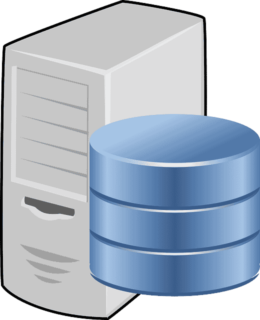MySQL database is a free and open-source Database solution for the user. This Database was developed to make the management of MySQL servers easier. With the help of this Database you can manage records that need to be used by multiple people. It is easy to understand because it is prepared using SQL (Structured Query Language). MySQL is capable of managing several million records.
How does a MySQL database work?
MySQL database is a very popular database that has many applications for the Website and use the server. Here we explain how a MySQL database works.
The MySQL database consists of a group of data files stored in a so-called Server & Hosting get saved. Each user has their own profile to authenticate themselves. Users can access the MySQL database via the web.
For example, if you save your email address in the database, you can access it using PHP use to view your emails. So if you PHP To retrieve your data in the MySQL database, it is necessary to set the file type:
$dbh = new PDO(); $dbh->setAttribute('type', 'mysql'); $dbh->connect('localhost','root','123456′); // The number of lines on the pictures var_dump($dbh->query('SELECT * FROM album')); // The number of lines in the images var_dump($dbh->query('SELECT COUNT(*) FROM album'));
Since the MySQL database contains data about all tables, you can also simply use SQL statements here.
Basics of database management with MySQL
MySQL is a world-famous database software that is used on a wide variety of platforms and operating systems. It is capable of running large company databases and can be particularly well suited for use in web applications. In this Article I will explain to you what MySQL is and what tasks are involved in database management.
The basics of MySQL:
MySQL is free, globally available database software. It is used, among other things, for use in web applications because it is very suitable for managing databases. With MySQL you can create databases from a wide variety of data sources and different formats. The functions of MySQL are very diverse and can help you to optimally manage your database.
What tasks can be performed in database management with MySQL:
MySQL is very suitable for preparing database content and transmitting it to the web user. It can also ensure that all database content is updated as new information is added. It can also ensure that the database is structured and maintained.
If you want to successfully approach database management with MySQL, it is essential to have the right ones Tools to know. I therefore recommend that you take a look at the article “The 20 Best MySQL Toolsto throw. This contains an overview of all the required ones Tools and tells you which programs are best suited for which tasks.
Using MySQL
If you want to use MySQL, you must first download the required programs. You can find the downloads at MySQL.com under Downloads. If you already use MySQL, you can also log into the database directly.
In this part I will address the following questions:
How can you best use MySQL?
To use MySQL, you must first install a program that supports MySQL. There are several such programs for Windows, but there is also something for Linux and Mac OS X. The most commonly used variant is phpMyAdmin, which also supports various other programs such as Cozy or Adminer. If you can't program MySQL yourself or can't afford it, for your Database of such programs To use, we recommend MySQL database development services. The company has been building some of the best MySQL database development services for years.
How do you read your files in MySQL?
If you use a MySQL database, you can read the files in the “my.cnf” file. This file is located in the MySQL installation. If you have the file “my.cnf” on your computer search, you can find it under “/usr/local/mysql/etc”.
How can you write data into the MySQL database?
If you want to write data into the MySQL database, you must first determine which formats you want to specify. To do this, click on the symbol “Formatted tables” and then select the desired method.
Most people use the following methods:
– Text: If you write data in text format, the TextBox “Text” opens. If you are not sure whether the contents of the TextBox fit in all lines, you can redirect the excerpt to one line.
– CSV: If you write data in CSV format, the CSV box opens. You can mark the dividing lines with commas or periods, and then insert each aspect of the data set individually into the field.
- Tabel: Opens the table by clicking on the menu button labeled “Table”. Then select the desired method in the “Content” drop-down list.
– Script: Opens the “Script” button and then clicks the “Enter” button. A text field will then open in which you can enter data.
– Dropdown: Opens the Method drop-down list and then selects the desired method.
How can I store my data in MySQL?
In my example, you will create a MySQL database in which you will store players' data. To save your data to the database you need to do the following:
1. Create a MySQL database. In this article I will tell you how to create a MySQL database.
2. Save your data in the database. In this article, I will tell you how to store your data in MySQL database.
3. If you need the data in the MySQL database, you can search for it from the database using SQL statements.
How do I manage data in my database?
The MySQL database is one of the most widely used databases worldwide. It is used by many companies to manage their IT systems. The MySQL database is simply explained!
The MySQL database is one of the most widely used databases worldwide. It is used by many companies to manage their IT systems. The MySQL database is based on SQL (Structured Query Language) and therefore provides users with the ability to perform many different tasks in their database.
Here's an example:
The MySQL database may use database systems to manage data, including providing user interfaces to users. It can also be used to collect statistical information about users.
Another task of the MySQL database is the creation of tables. This is a type of data set that provides the data in a specific structure. An example of this is the “Name” table in your MySQL database. The table contains all personal names that are registered on your system, for example.
Creating a MySQL database
If you want to create a MySQL database, it's relatively easy. However, you should know exactly what you are doing beforehand Functions of mysql bin because they are needed to create the database. This includes, among other things, the option of integrating a database into the web browser. You should consider the following steps when creating your MySQL database:
1. If you are already familiar with MySQL, use it and log in to the respective management panel.
2. As root, add the command mysql -u root -p bin/mysql_init_db.php to your PC. This creates the MySQL database.
3. From the MySQL database create an HTML file with the following content:
mysql_connect(“localhost”, “root”, “”) or die(“ERROR”,”Could not connect to the MySQL server”);
mysql_select_db(“nameofdb”);
?>
setAccess($access); ?>
4. Now paste the HTML file into your browser to open the database.
5. Click on the “Manage Content” button to manage the database. If you want to create a new MySQL database, you will need to go through these steps already.
MySQL database: the structure and function
It is used in many companies, such as Amazon, eBay or Google. If you want to store your data in a MySQL database, there are several options. Here we explain the most important aspects of the MySQL database structure and function.
The MySQL database is a modern database structure that is used in many companies. It consists of text files connected to the MySQL server software. Each user can store what they need in a MySQL database.
The MySQL database is very modular. This means that there are several components in the database: the server software, the application developers for SQL (Structured Query Language) and other programming interfaces, and notation for data sets. This makes it possible to manage various data sets in a MySQL database.
The database is capable of answering multiple queries at the same time. This is essential if you have multiple users who want to store data in your MySQL database at the same time.
Finally, there is also the option of building a MySQL database. To do this, you not only need the server software and SQL interfaces, but also the correct notation for data records.
What data is stored in a MySQL database?
A MySQL database is a collection of data that can be used for management and archiving purposes. Some of the types of data stored are: names, addresses, phone numbers, text data, photos and PDF documents.
What types of data can be found in a MySQL database?
Most data types can be found in a MySQL database. The most important are: names (owners, name tags), addresses (owner, address), telephone numbers (connections and participants), text data (texts, letters follow), photos (files with pictures) and PDF documents (files with fonts).
Evaluating data in a MySQL database
It offers a wide variety of options for analyzing and structuring data. Among other things, you can take into account which data should be stored in which order in order to use certain areas more efficiently. Here are some tips for evaluating data in a MySQL database.
1. Determine what you want to achieve: If you already want to produce statistical information or custom dashboards, all you need are datasets with existing registration. If you only need statistical data, there are various statistics programs available that also use MySQL databases. Among other things, you can use the statistical evaluation program phpMyAdmin.
2. Manage your data: If you already want to produce datasets with specific information or dashboards, you need access to that data. To do this, you need to create a user for data processing and determine the desired statistics. Alternatively, you can also use the MySQL server as Host use for your own web portal.
3. Structure your data: Structuring your data is crucial so that you can use it efficiently. You can do this by examining what information should be stored and in what order to reduce problems. Structured data also helps you use your MySQL database more efficiently. For example, you can use different data types to find information more quickly and easily.
4. Analyze your data: If you already have statistical or structured data, you can analyze it to better identify problems. To do this, you often need help from system administrators or computer scientists.
How can you make changes in a MySQL database?
To make changes in your MySQL database, you first need a MySQL configuration. You can create these with the following command:
mysql -u root -p
After you have created your MySQL configuration, you can make changes in the database. The configuration can be found under Database Options > Safety > User control bar. Under this control bar you can specify the access permission that you must assign to the MySQL database. If you have already used the access permission, you need to change it to make changes in the MySQL database.
How do you use your MySQL database on the Internet?
If you are using a MySQL database to store data over the Internet, it is important that you configure your database correctly.
First you need to register with your MySQL server. Here you can find more information about the ways to manage your database.
After you have registered with your MySQL server, you can do the following:
1. starten The MySQL server and log in.
2. Add the MySQL database to the index of your table of contents.
3. Click the Database Connection Option button and enter the MySQL server address.
With these steps, connecting the database to the MySQL server is done!
If you now want to save data over the Internet, please use the following:
1. Write a MySQL query to a text file, e.g. myquery.txt.
2. Paste this file into your content server, e.g. http://myserver.com/myquery.txt.
3. Click the Save button and then click the Link Save data in the browser window of the table of contents that now opens!
You can now open the executed query in your browser and view the data in it show.
What databases are there?
MySQL is one of the most widely used database systems. Many companies now use it as a Basis for their websites and thus also for the provision of documentation. In this article I explain what advantages MySQL offers and what alternatives there are.
The alternatives to MySQL are PostgreSQL, MongoDB and Oracle Database. I cover the databases in a separate article.
Summary
This article explains the basics of the MySQL database. The topic includes the operation of MySQL and its use in a Website or a blog.
The topic of MySQL is relatively new, so it's worth it Get to know the basics. The following summary provides an overview of the most important parts of the MySQL database.
First, we look at what data can be stored in the MySQL database and what functions this data enables. Then it is examined which ones Tools can be used for the administration of MySQL and how to create user profiles. Finally, the various ways and options are discussed as to how you can convert the MySQL database into one Website or embed a blog.





